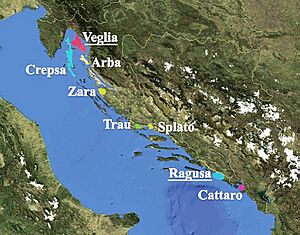Dalmatian City-states facts for kids
The Dalmatian City-states were a group of eight special cities located along the coast of Dalmatia. These cities were places where the original Dalmatian Italians managed to survive after the Western Roman Empire fell. This happened when new groups, like the Slavs, moved into the area. The cities were Zara, Spalato, Ragusa, Cattaro, Trau, Ossero (also called Cherso or Crespa), Veglia, and Arbe.
Contents
A Look Back: How the Cities Began
Surviving the Invasions
Around the early 600s AD, a group called the Avars, along with some Slav tribes, attacked and took over the Roman province of Dalmatia. The local Latin-speaking people only survived in the coastal areas and on the islands of Dalmatia.
There, they created eight small cities. These cities kept their connections with the Byzantine Empire, which was a powerful empire in the East. The Byzantine Empire helped protect these cities, which allowed them to trade and grow.
Names and Language
The original names of these cities were Jadera, Spalatum, Crespa, Arba, Tragurium, Vecla, Ragusium, and Cattarum. At first, the people spoke Latin and followed Roman laws. But after a few centuries, they developed their own unique language. It was a new Latin-based language called "Dalmatico." This language was spoken until the 1800s.
Trade and Venetian Influence
These cities were important centers for sea trade. They traded a lot with the Italian peninsula and with the growing Republic of Venice. From Venice, they learned about Italian culture and art.
After the year 1000 AD, the leader of Venice, called the Doge Orseolo II, started to control the Dalmatian coast. However, it wasn't until 1420 AD that Venice fully took over these City-states.
Under Venetian Rule
Because of this, seven of these cities became part of the Venetian Republic. Zara was considered the most Venetian, or Italian, of them all. It remained Italian until WWII.
But one of the City-states, Ragusium (also known as Ragusa), was only controlled by Venice for a few decades in the 1000s. Later, it became the famous "Repubblica di Ragusa," which means the Republic of Ragusa. This was an independent state that had the protection of the Ottoman Empire. It lasted until Napoleon conquered it in 1804 AD. After that, it became part of Napoleon's Kingdom of Italy.
Related pages


